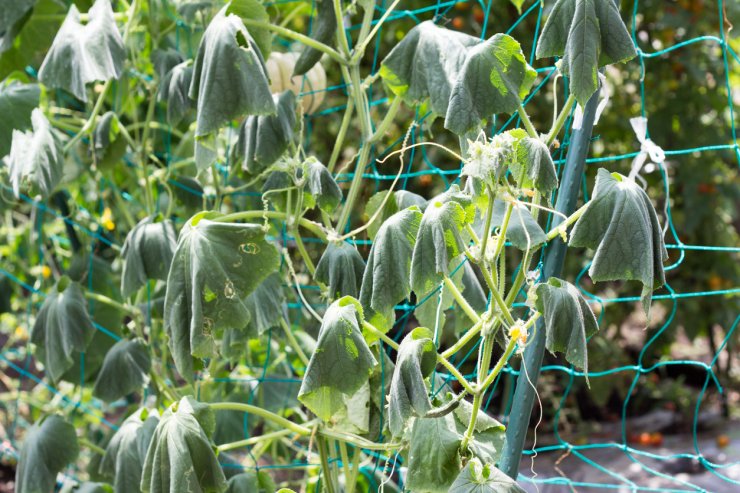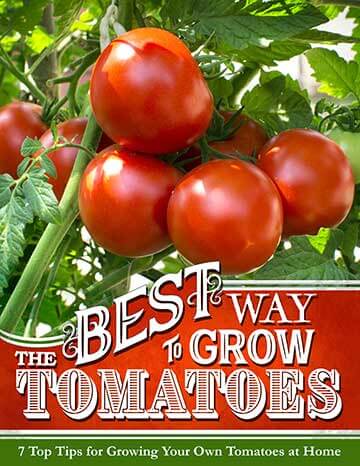
Wilted cucumber plant
I’ll be the first to admit that I have an overwatered plant or two in my garden every year. It’s not so bad now, but my indoor plants used to try their best to run away when they saw me coming with the watering can. Spoiler alert: They didn’t get very far.
In my defense, I was not very informed as to how much water plants need. I just assumed you had to water indoor plants once or twice each week, and every day for outdoor vegetables. Wouldn’t you know, there’s a little more to it than that, like how close to a heat source your indoor plants are, or how windy it is for your outdoor plants. Lucky for me (and my vegetables) there are a few ways to tell if you have an overwatered plant.
Discover 7 top tips for growing, harvesting, and enjoying tomatoes from your home garden—when you access the FREE guide The Best Way to Grow Tomatoes, right now!
The 7 telltale signs of an overwatered plant
1. Wilted leaves. Whether you have an underwatered or overwatered plant, you’ll likely see leaves that look sad. The difference between the two is that an overwatered plant will have yellowed, soggy-feeling leaves.
2. Brown leaves. Like wilted leaves, brown leaves can be a sign of either too much or too little water. How can you tell the difference? Dig down into the soil a bit with your finger and see what it feels like. Even soil that’s dry at the surface could be quite wet once you get down an inch or so.
3. Shedding leaves. All plants drop leaves, but if you’re finding both new and old leaves dropping from your plants, there’s a darn good chance you’ve overwatered.
4. Mushy stems. How does the base of your plant feel? Is it weak and soggy? You guessed it: too much water.
5. Moldy soil. If you’re finding the surface soil around your plant is moldy or growing fungus, that’s a definite sign of an overwatered plant. Remove the affected soil and make sure it has a chance to dry.
6. Blistered leaves. When plants get too much water too quickly, their leaves fill with fluid and the cells burst.
7. Root rot. This identifier may be a little harder to notice, but it can be fatal to plants. Your best bet here is to dig up the plant and try to clean out the roots by shearing off any dead and rotten sections. You may also need to trim back any foliage. Run the roots under clean water and repot the plant in a clean pot with fresh soil, or plant it in a new area in the ground, ensuring the soil is free of mold and mildew first.
Discover 7 top tips for growing, harvesting, and enjoying tomatoes from your home garden—when you access the FREE guide The Best Way to Grow Tomatoes, right now!
How to cure an overwatered plant
Aside from root rot, the easiest and most effective way to fix an overwatering problem is to just change your evil ways and stop watering your plants. In most circumstances, that will be enough to get your plant back to full strength and living a happy plant life.
For more severe cases, move your plant to a shady spot (assuming it’s in a container). We don’t want the water to evaporate too quickly. One extreme to another is not a great situation for plants. If it’s really in rough shape, take the same steps that you would for root rot.
Lastly, change how you water your plants. Check the soil every couple of days by pushing your finger in an inch or two. If the soil is wet, your plant does not need water.
That’s really it. The secret to keeping your plants happy and healthy is to try to catch these issues as soon as you can. Just like with humans, the sooner you can catch a problem, the sooner and more successfully you can correct it.
What’s your story on overwatered plants? Any tips or advice you’d like to share in the comments?
Discover 7 top tips for growing, harvesting, and enjoying tomatoes from your home garden—when you access the FREE guide The Best Way to Grow Tomatoes, right now!





This is my 3rd year growing a garden. It is the first that has produced, because I stopped overwatering. It’s amazing what can happen if I just leave well enough alone!
I’ve read on garden posts that if you have mushrooms growing, it means your soil is good but I thought fungus is bad. “They” always state “not to worry”.
I trust you more!! So, what is your opinion, Amanda?
Thank you in advance.
Elaine
We’re on the side of “don’t worry.” The majority of mushroom activity happens below the surface of your garden and most varieties will not cause any damage. In fact, mushrooms send out a network of filaments that can create a symbiotic relationship with plant roots. These filaments tend to increase the surface area of the plant’s roots, which may improve its ability to take up water and nutrients from the soil and improve overall drought tolerance and disease resistance.
I have a system of bottles 6″ tall I drill a hole in the side at 5″ leaving a space with no water. I use a lick protein tub.
Professor Kratky. Fill to hole overflow good for weeks. Anyone else heard of this?
I don’t understand your system. Please explain further?
We have had close to record rain this spring in Washington State and my Plum tree flowered, leafed and now half the tree leaves have shriveled and dropped so how do you stop Mother Nature? Will it recover once drier weather begins?
Thank you Amanda.
My croton tree died for two reasons too much water and no holes to drain it out. Plus it was in my living room. And it was so pretty. Now I have a cacti that its leaves are falling. As I read then it must be too much watering.
I will check them more frecuently. ????
Oh man, cacti and I aren’t friends, and it’s because I over-water. I once killed a 6ft tall cactus that had clearly survived for probably 20 years until I got ahold of it. And even recently, I had a cactus that had been perfectly happy abandoned on my fireplace for five years, and I decided to start watering it every once in a while and guess what – DEAD. And it happened practically overnight. I like to stick to fruits and veggies who appreciate it (mostly). Ha!
Thanks! I needed this. I,too, have a tendency to over water. Gives me a lot to think about.